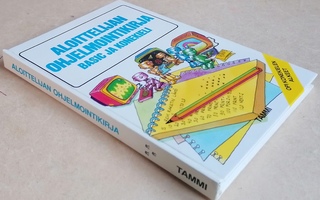3 DIFFENRENT LANGUAGE
Modern Finland
La Finlande Moderne
Modernes Finnland
136 sivua pages
Reilusti yli 100 valokuvaa Helsingistä ja muualta suomen kaupungeista
MODERN FINLAND
FINLAND! What is it like?
Vast forests of pine, spruce and birch... Thousands and thousands of lakes (precisely how many, nobody seems to know)... A long, broken coastline and countless islands... Modern cities with broad streets, parks on every hand and buildings designed in a bold, ad- venturous manner... Prize-winning ceramics and glassware... Lady dentists and barbers and streetcar conductors... Champion runners and skiers... Male choruses with thunderous basses... Long winters and fleeting summers (>>Finnish summers are really very beautiful — but short,» a current joke goes. >>Last year it came on a Thursday.>>) ...Midnight sun... Blue-eyed people... who »pay their debts>>... Sauna... Sisu... Sibelius...
These are some of the things that make up Finland.
The map shows Finland situated uncomfortably near the North Pole. It probably intimidates many travelers, keeps them from visiting the country. But the climate is actually surprisingly mild. Farming is
practised far above the Arctic Circle, and the best potato crops come from the Far North. Generally, about the same clothing will serve you in Finland as in England at any given season need a raincoat nearly so often in Finland. And the Finns think it except that you don't a good joke to assure foreigners they need not fear ever coming face to face with a Polar bear in the streets of Helsinki. -
A northern climate, some students of civilization have concluded, tends to promote, rather than to retard, progress. The northern coun- tries of Europe are cited as evidence. In any case, the Finns and their Scandinavian brothers have a reputation for being hard workers and getting things done. No doubt, their bracing climate has something to do with it. At least, they never have to call a halt for a siesta.
Before they reached the road to progress, however, the Finns had to overcome formidable handicaps. Taming the northern wilds to the service of man required the exertions of many generations. The in- habitants of warmer climes to the south got a head start of centuries in the arts of civilization.
Not that the Finns of ancient times were backward! Archeology has unearthed relics that prove that the Finns possessed a highly de- veloped rustic culture long before their recorded history began shortly after the turn of the millenium.
The ancestors of the present-day Finnish nation migrated to this country about the time of Christ and in succeeding centuries from the Baltic region south of the Gulf of Finland. Christianity was esta- blished some 800 years ago by Crusaders from Sweden. In the wake of religion followed political rule. For more than six centuries the destinies of the Finnish and Swedish peoples were joined. They were subjects of the same king, whom they elected on an equal footing; and they worked together in creating common social, political and cultural institutions. In a very real sense, the Finns and Swedes were partners.
The effect was to link Finland to the Scandinavian cultural com- munity. Apart from language, there are few fundamental differences between the folkways of Finland and Sweden.
The political ties with Sweden were broken during the heyday of Napoleon, who, in a typical imperialistic deal, told the Czar of all the Russias that Finland was his for the taking. Finnish resistance was bitter but, in the absence of Swedish aid, it was eventually beaten down by the vastly greater Russian forces. However, the Czar deemed it wise not to act the part of conqueror but as liberator. Inclining an ear to a Finnish adviser, who had been forced into exile for having conspired against the Swedish King in favor of national independence,
the Czer welcomed Finland into the family of autonomous nations. He gave a solemn pledge to honor Finland's traditional laws and institutions and to uphold her long-established system of home rule. Hardly a generation of Finns up to then had escaped war. Their
country had been sliced up time and again by treaties calling off hosti- lities. Many of the Swedish monarchs had been highly ambitious. The realm of Sweden-Finland had grown and become a great power. The Finns had won world fame as soldiers. Royal ambitions, however, had been directed southward, ever farther from the homeland; and the flower of Finnish manhood had been constantly conscripted for expeditions of conquest. Finland herself had been often left without men or arms for defense. It had invited invasion along the exposed eastern frontier. While Finnish warriors were winning dubious glory on distant battlefields, their wives and children were often hiding like hunted animals in the woods as invaders ravaged the land.
Under such conditions, it is a wonder civilization ever flourished in Finland. But it did! The Finnish people may be short on material re- sources and favoring circumstances, but they have never been short on resolution, hope and faith in the future.
This was proved once more in World War II and during the postwar ordeal of recovery. Reconstruction was started in the immediate wake of destruction. The northern third of Finland was described by UNRRA observers just after the war as the most utterly devastated area in Europe. The task of rebuilding on top of the ruins appeared hopeless to everyone, that is, except the homeless native inhabitants. In five short years reconstruction was completed. And the paying off of the war reparations to the last cent by 1952 was regarded by many economic experts as a >>miracle.>>
Finland looks like a new country. >>How modern!» is an exclamation often heard from the lips of foreign visitors. Yet, as we have noted in this brief review, Finland is really a very old country. Fire and war are to blame for having destroyed so much of the visible heritage of the past. Because the vast forests of Finland have always provided an inexhaustible supply of timber, the Finns throughout the centuries built mostly in wood. Unfortunately, wood burns easily and therefore the past has repeatedly gone up in smoke. That is perhaps the chief reason why Finland, rebuilt time and again, looks so new.
The spiritual heritage of the Finns could never, however, be destroy- ed either by fire or war. And freedom is the legacy the Finns cherish above all else. They are proud that their nation has never known slavery, and they are determined never to let the torch of freedom go out.

